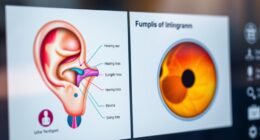Safeguarding our hearing from the hazards of high volume levels on Windows calls for a delicate equilibrium; it’s about savoring sound while also safeguarding our ear health.
A common misconception is that simply adjusting the volume is enough to protect our ears, but the real solution delves deeper into the system settings.
By implementing a few strategic tweaks and understanding the intricacies of audio management, we can steer clear of potential hearing damage.
Let's explore how we can take proactive steps to disable high volume effectively and preserve our auditory health for the long haul.
Key Takeaways
- Customize volume limits in Windows to safeguard against hearing damage.
- Adjust settings to regulate volume levels and prevent high decibel exposure.
- Utilize built-in features like Realtek audio drivers for safe listening practices.
- Monitor and tailor volume settings regularly for optimal hearing protection.
Importance of Hearing Protection
Why is hearing protection crucial in preventing irreversible damage to our ears?
Hearing loss, affecting a staggering 466 million individuals globally, often stems from preventable causes such as exposure to high volume levels. The insidious nature of high decibel sounds can't be overstated, as prolonged exposure exceeding 85 decibels can result in permanent hearing damage.
Tinnitus, characterized by a persistent ringing sensation in the ears, frequently manifests as a consequence of subjecting our ears to excessively loud environments. To mitigate these risks, it's imperative to adhere to prudent practices.
For instance, utilizing headphones at a moderate 60% volume for a maximum of 60 minutes a day can significantly reduce the likelihood of incurring hearing impairment. Additionally, implementing volume restrictions and taking periodic breaks while engaging in activities involving heightened sound levels serve as effective safeguards against potential hearing loss.
Understanding Volume Settings on Windows

To safeguard your hearing health while using Windows, understanding the volume settings is crucial for preventing potential damage to your ears. Here's a breakdown to help you grasp the volume settings on Windows:
- Volume Range: Windows volume settings span from 0 to 100, with 100 representing the maximum volume level.
- Adjustment Options: You can modify the volume via the volume control icon in the taskbar or through the Volume Mixer within Windows.
- Hearing Risk: Prolonged exposure to volumes exceeding 85 decibels can lead to hearing loss.
- Protective Measures: Windows offers the ability to set volume limits, especially beneficial when using headphones, to avert hearing damage.
Understanding and manipulating volume settings in Windows empowers you to take charge of your auditory well-being. Familiarizing yourself with these settings, including how to manage RealTek audio drivers through Device Manager and disable high volume levels permanently, can significantly contribute to preserving your hearing in the long run.
Step-by-Step Guide to Adjusting Volume Limits
Customizing volume limits in Windows can be easily achieved by navigating to the Sound settings in the Control Panel. By setting a maximum volume level, you can prevent excessive loudness that may lead to hearing damage. To adjust these limits, first, access the Control Panel on your Windows device.
Within the Control Panel, locate the 'Sound' settings, which allow you to fine-tune audio preferences. Look for options related to volume control, and adjust the sliders to set your desired maximum volume level. It's crucial to customize these restrictions based on personal preferences and safety considerations to ensure a safe listening experience.
Furthermore, enabling volume limiting features can enhance your overall audio experience by prioritizing your well-being. Regularly monitoring and adjusting volume settings is essential for maintaining optimal hearing health, especially when using headphones or speakers. By taking these steps, you can enjoy audio on your Windows device while keeping your ears safe from potential harm.
Utilizing Built-In Windows Features

Transitioning from adjusting volume limits, Windows offers users a range of built-in features designed to enhance audio experiences while safeguarding against potential hearing loss. By leveraging these tools effectively, users can enjoy sound at safe levels without compromising quality.
Here's how to make the most of these features:
- Customize Volume Limits: Utilize Windows settings to set maximum volume levels, ensuring you stay within safe hearing thresholds.
- Adjust App Volume: Tailor volume levels for individual applications to prevent sudden loud sounds that could harm your ears.
- Sound Enhancements: Explore Realtek High Definition Audio or other built-in sound enhancements to optimize audio output for clarity even at lower volumes.
- Accessibility Settings: Enable visual cues or notifications for volume levels through accessibility settings, aiding in better hearing protection.
Additional Tips for Safe Listening
In maintaining safe listening practices, it's crucial to implement additional strategies beyond volume control to protect your hearing effectively. When playing audio on Windows, ensuring your Realtek drivers are up to date is vital for maintaining a volume at a safe and comfortable level. Outdated drivers can lead to unexpected volume spikes, potentially endangering your hearing health. To update your Realtek drivers, navigate to the Device Manager, locate the Sound, video, and game controllers section, right-click on Realtek, and click Update Drivers. By staying proactive in managing driver updates, you can minimize the risk of sudden loud audio that could harm your ears.
Furthermore, taking regular breaks from listening sessions is essential in reducing the risk of long-term hearing issues. During these breaks, give your ears a chance to rest and recover from prolonged exposure to sound. When returning to listening, be mindful of the volume settings, especially in noisy environments where there may be a tendency to turn up the volume excessively. Incorporating noise-cancelling headphones can also help block external sounds, reducing the need for high volume levels and providing a safer listening experience overall.
Frequently Asked Questions
How Do I Turn off the Volume Warning in Windows 11?
Sure! To turn off the volume warning in Windows 11, go to Settings > System > Sound, then toggle off 'Show a warning when the volume is too loud.'
By doing this, you can manage your audio levels without interruptions. Customizing these settings aligns with your preferences for audio output.
How Do I Turn off Windows Volume Control?
When it comes to turning off Windows volume control, it's important to navigate to the Volume Mixer to make adjustments.
By customizing volume levels for different apps and devices, you can effectively manage sound output.
However, remember that muting specific applications or adjusting volume levels independently within the Volume Mixer is key to a personalized audio experience on Windows.
How can we assist you further with your Windows volume control needs?
How Do I Turn off Ear Protection?
Sure, to turn off ear protection on Windows, access Manage Audio Devices and uncheck the Ear Protection option. Disabling this feature allows for higher volume levels.
It can prevent the volume warning from appearing and enhance your audio experience. Customizing audio settings by adjusting Ear Protection is a practical way to manage audio output.
This solution ensures you have control over your Windows audio settings for optimal usage.
How Do I Stop My Computer From Making Noise When I Change the Volume?
We've got you covered when it comes to stopping your computer from making noise when adjusting the volume. By tweaking the sound settings in Windows, you can ensure a smooth transition without those jarring noises.
Properly configuring the volume control settings and utilizing shortcuts or multimedia keys can help you avoid sudden loud sounds. With a few adjustments here and there, you'll be able to enjoy a more peaceful audio experience on your Windows system.
Conclusion
In conclusion, it's essential to prioritize our hearing health by taking steps to disable high volume on Windows.
By following the steps outlined in this guide, we can prevent hearing loss and ensure safe listening practices.
Remember, our ears are irreplaceable, so why not take the necessary precautions to protect them?











